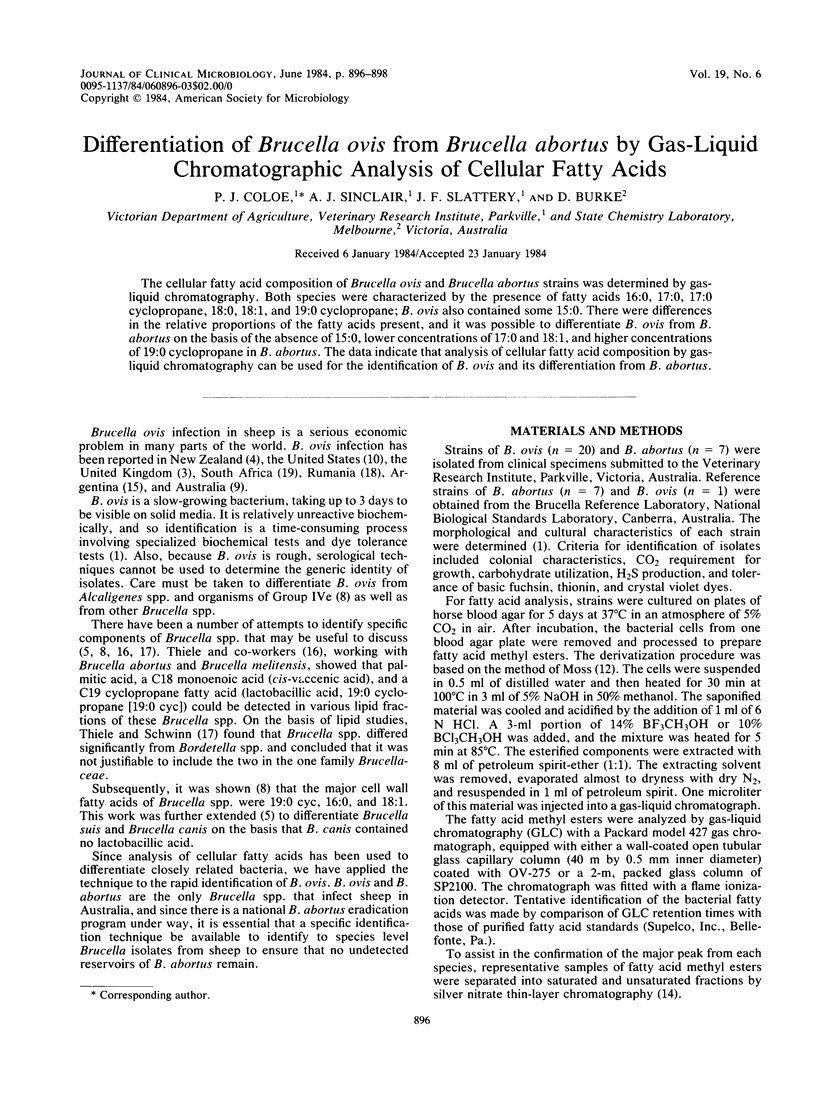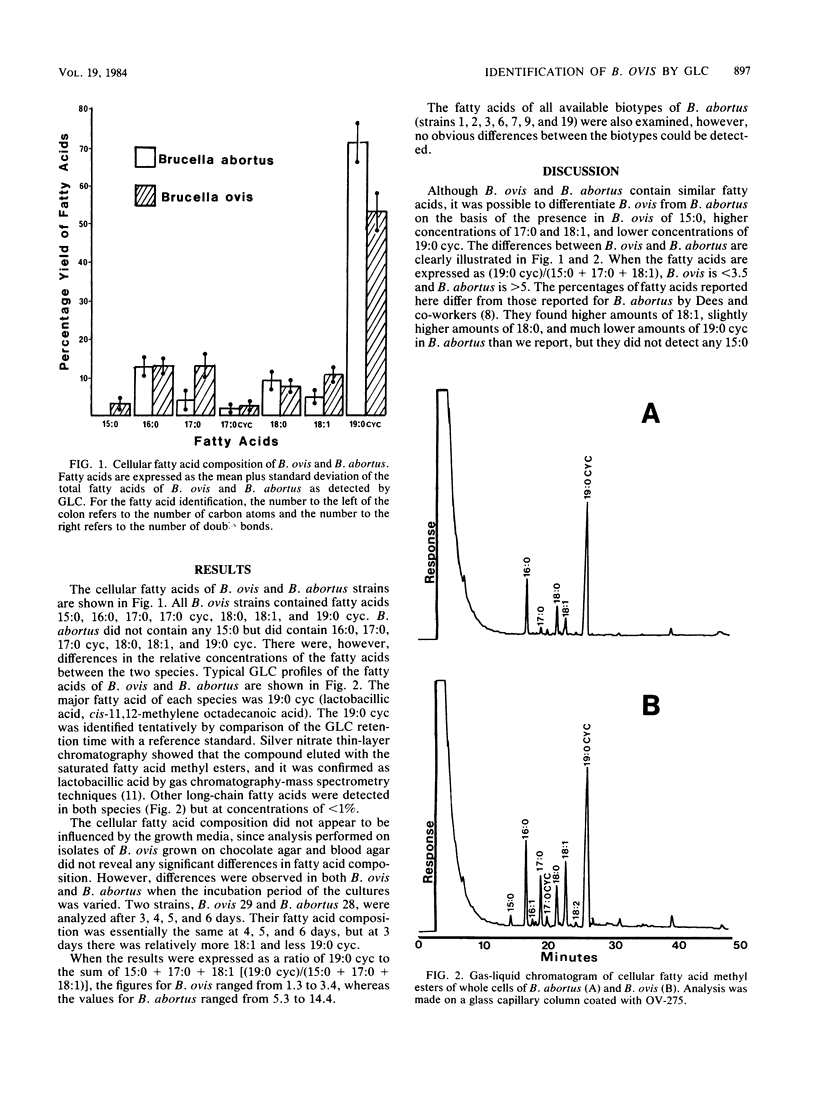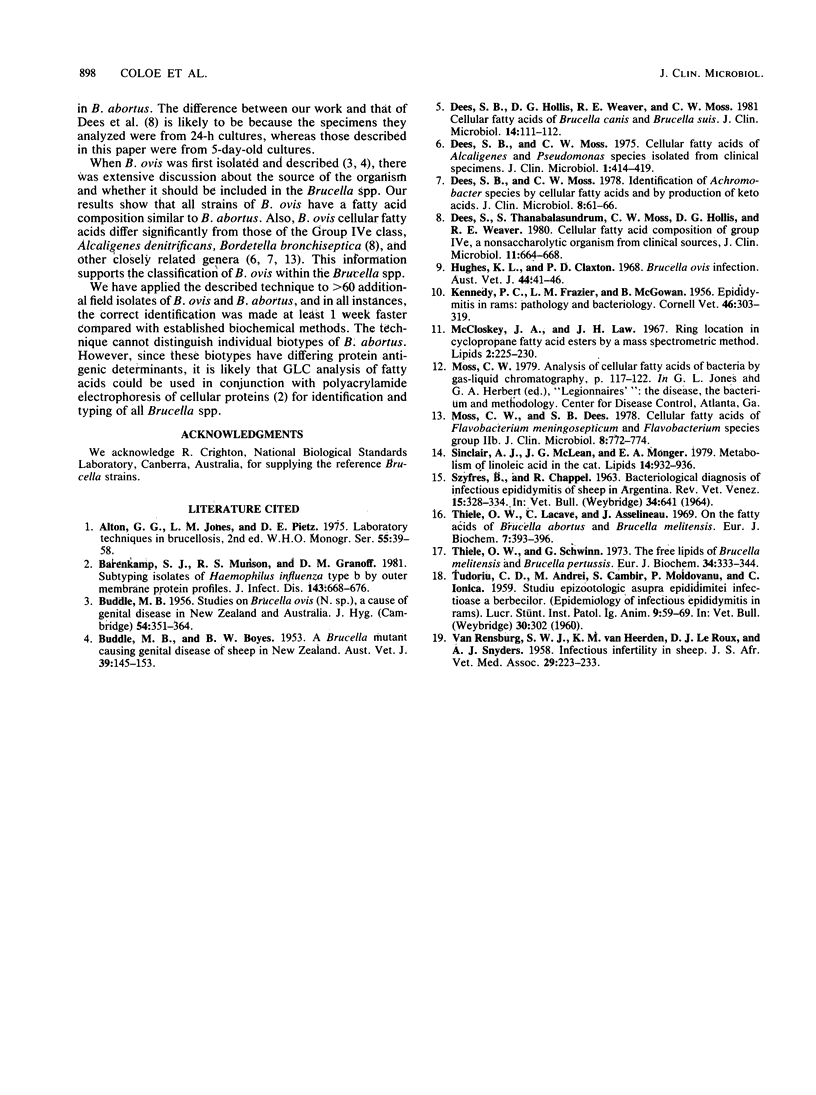Abstract
The cellular fatty acid composition of Brucella ovis and Brucella abortus strains was determined by gas-liquid chromatography. Both species were characterized by the presence of fatty acids 16:0, 17:0, 17:0 cyclopropane, 18:0, 18:1, and 19:0 cyclopropane; B. ovis also contained some 15:0. There were differences in the relative proportions of the fatty acids present, and it was possible to differentiate B. ovis from B. abortus on the basis of the absence of 15:0, lower concentrations of 17:0 and 18:1, and higher concentrations of 19:0 cyclopropane in B. abortus. The data indicate that analysis of cellular fatty acid composition by gas-liquid chromatography can be used for the identification of B. ovis and its differentiation from B. abortus.
Full text
PDF


Selected References
These references are in PubMed. This may not be the complete list of references from this article.
- BUDDLE M. B. Studies on Brucella ovis (n.sp.), a cause of genital disease of sheep in New Zealand and Australia. J Hyg (Lond) 1956 Sep;54(3):351–364. doi: 10.1017/s0022172400044612. [DOI] [PMC free article] [PubMed] [Google Scholar]
- Barenkamp S. J., Munson R. S., Jr, Granoff D. M. Subtyping isolates of Haemophilus influenzae type b by outer-membrane protein profiles. J Infect Dis. 1981 May;143(5):668–676. doi: 10.1093/infdis/143.5.668. [DOI] [PubMed] [Google Scholar]
- Dees S. B., Hollis D. G., Weaver R. E., Moss C. W. Cellular fatty acids of Brucella canis and Brucella suis. J Clin Microbiol. 1981 Jul;14(1):111–112. doi: 10.1128/jcm.14.1.111-112.1981. [DOI] [PMC free article] [PubMed] [Google Scholar]
- Dees S. B., Moss C. W. Cellular fatty acids of Alcaligenes and Pseudomonas species isolated from clinical specimens. J Clin Microbiol. 1975 May;1(5):414–419. doi: 10.1128/jcm.1.5.414-419.1975. [DOI] [PMC free article] [PubMed] [Google Scholar]
- Dees S. B., Moss C. W. Identification of Achromobacter species by cellular fatty acids and by production of keto acids. J Clin Microbiol. 1978 Jul;8(1):61–66. doi: 10.1128/jcm.8.1.61-66.1978. [DOI] [PMC free article] [PubMed] [Google Scholar]
- Dees S., Thanabalasundrum S., Moss C. W., Hollis D. G., Weaver R. E. Cellular fatty acid composition of group IVe, a nonsaccharolytic organism from clinical sources. J Clin Microbiol. 1980 Jun;11(6):664–668. doi: 10.1128/jcm.11.6.664-668.1980. [DOI] [PMC free article] [PubMed] [Google Scholar]
- McCloskey J. A., Law J. H. Ring location in cyclopropane fatty acid esters by a mass spectrometric method. Lipids. 1967 May;2(3):225–230. doi: 10.1007/BF02532560. [DOI] [PubMed] [Google Scholar]
- Moss C. W., Dees S. B. Cellular fatty acids of Flavobacterium meningosepticum and Flavobacterium species group IIb. J Clin Microbiol. 1978 Dec;8(6):772–774. doi: 10.1128/jcm.8.6.772-774.1978. [DOI] [PMC free article] [PubMed] [Google Scholar]
- Sinclair A. J., McLean J. G., Monger E. A. Metabolism of linoleic acid in the cat. Lipids. 1979 Nov;14(11):932–936. doi: 10.1007/BF02533508. [DOI] [PubMed] [Google Scholar]
- Thiele O. W., Asselineau J., Lacave C. On the fatty acids of Brucella abortus and Brucella melitensis. Eur J Biochem. 1969 Jan;7(3):393–396. doi: 10.1111/j.1432-1033.1969.tb19621.x. [DOI] [PubMed] [Google Scholar]
- Thiele O. W., Schwinn G. The free lipids of Brucella melitensis and Bordetella pertussis. Eur J Biochem. 1973 Apr;34(2):333–344. doi: 10.1111/j.1432-1033.1973.tb02764.x. [DOI] [PubMed] [Google Scholar]


